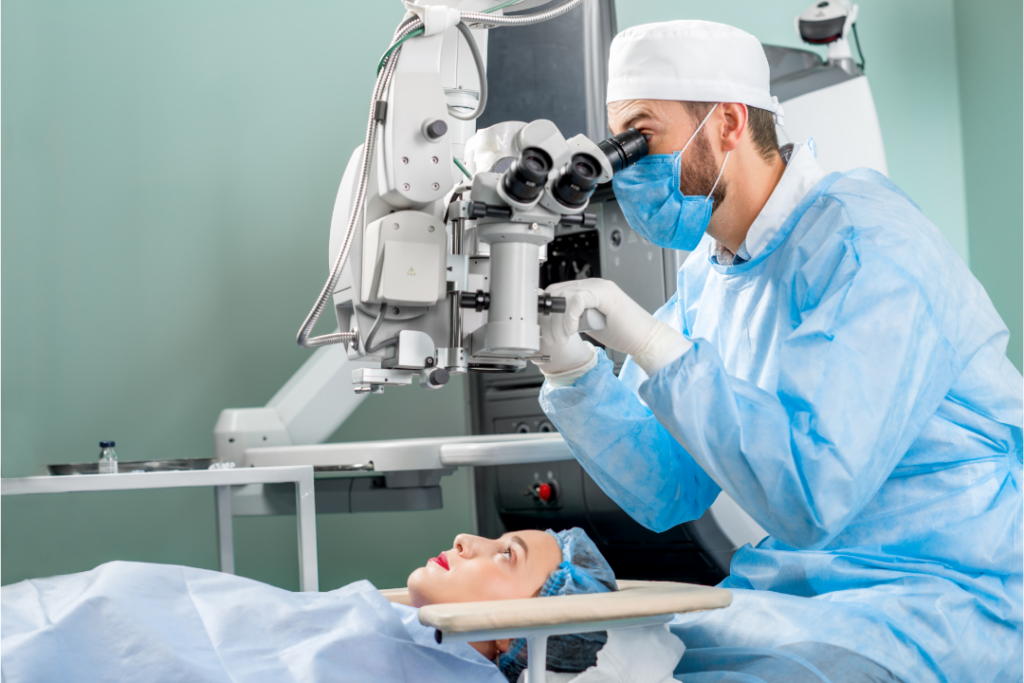Seeing clearly is one of life’s quiet joys. Reading a book in bed without fumbling for glasses. Walking into a warm room on a winter day and not watching your lenses fog. Diving into the ocean and actually seeing the reef below. Clear vision isn’t just practical—it changes how you move through the world.
That’s why interest in laser eye surgery—including well-known procedures like LASIK and PRK—continues to grow. For many, it’s a safe, effective way to correct nearsightedness, farsightedness, and astigmatism. But the real story isn’t just about ditching glasses. It’s about the ripple effects on your time, confidence, and long-term quality of life.
Below, I’ll explain what makes laser eye surgery more than a convenience, what life looks like on the other side, how the technology works, who tends to benefit most, and what to consider before you decide.
Why It’s More Than Convenience
Freedom from daily maintenance
Glasses and contacts work—until they get in the way. Frames slip during workouts. Contacts dry out at the end of a long day. Travel means packing cases, solutions, backups, and prescriptions. Laser eye surgery removes the daily maintenance step. You don’t think about your vision all day; you simply use it.
Confidence and lifestyle upgrades
Consider all the moments where eyewear inserts a small barrier between you and the experience. Running in the rain. Playing pickup basketball. Wearing eye makeup without worrying about smudges on lenses. Posing for photos without glare. These are small things, but stacked together they create a noticeable lift in confidence and comfort.
A financial shift, not just a medical one
Think about the ongoing costs of vision correction over a decade or two: frames, replacement lenses, sunglasses with prescriptions, contact lens boxes, solutions, re-fittings, and updated exams. Laser eye surgery is an upfront investment that often reduces or eliminates many of those recurring expenses. It’s like prepaying for years of clarity—and time saved.
See more: Home Sleep Test Australia: Convenient Testing from the Comfort of Home
Life Improvements After Surgery
The morning moment
One of the most common stories I hear from patients is about the first morning. You open your eyes and read the clock across the room. You can see the leaves on the tree outside, not just a green blur. It’s simple, but it feels like waking up to a new world.
Everyday ease
- Work: Less eye strain from contacts at a computer. No more searching for readers and switching back and forth.
- Fitness: Running, swimming, yoga, and team sports feel more natural without fogging or slipping frames.
- Travel: Fewer items to pack and keep sterile. No emergency runs for solution or a torn lens.
Psychological benefits
When a task stops requiring constant management, stress drops. Many patients describe an emotional “lightness” after surgery. They aren’t thinking about lenses. They’re thinking about life. For some, that shift improves self-image and social comfort, which can have positive effects on mood and motivation.
Analogy: Imagine upgrading from a car you have to tinker with every morning to one that simply starts and drives. The destination is the same, but the ride is calmer, and you’ve reclaimed mental bandwidth every day.
Understanding the Technology & Safety
How it works, simply explained
Your cornea—the clear front window of your eye—bends light so it focuses on the retina. If the cornea’s shape is off, the focus lands in front of or behind the retina, causing blur. Laser procedures gently reshape the cornea so light focuses precisely.
- LASIK: A very thin flap is created on the corneal surface. The laser reshapes the layer beneath, and the flap is placed back like a natural bandage.
- PRK: The surface skin (epithelium) is removed, the laser reshapes the cornea, and the surface layer regrows over a few days.
Both approaches use highly precise, computer-guided lasers that track natural eye movements in real time. It’s like a GPS-guided sculpting tool that adjusts every millisecond.
Safety in the modern era
Modern systems use detailed maps of your cornea—think of a topographic map of a landscape—to plan treatment down to microns. Numbing drops keep you comfortable. You remain awake, but the procedure is brief. Most people describe pressure and bright lights, not pain.
No medical procedure is “risk-free,” but laser eye surgery’s safety record is strong when patients are well-selected and aftercare instructions are followed. Choosing an experienced surgeon and a transparent clinic is part of that safety net.
When It Makes Sense to Consider Surgery
Vision issues addressed
- Nearsightedness (myopia): Distant objects appear blurry.
- Farsightedness (hyperopia): Near tasks are challenging; distance can also blur.
- Astigmatism: Vision is distorted at multiple distances due to an uneven cornea.
If your prescription is within treatable ranges and has been stable for at least a year, you may be a candidate.
Age and timing
Adults in their 20s to 40s often benefit most. By your 20s, prescriptions tend to stabilize. In your 40s and beyond, a separate age-related change called presbyopia can affect near vision even if distance vision is crystal clear. That doesn’t disqualify you, but it may change the plan (for example, blended vision strategies).
Lifestyle considerations
- Active jobs or hobbies: First responders, athletes, travelers, and outdoor workers often find surgery especially helpful.
- Contact lens intolerance: If your eyes are chronically dry or irritated with lenses, surgery can be a relief.
- Long-term planners: If you prefer a one-time intervention to ongoing maintenance, the calculus leans toward surgery.
Analogy: Deciding on surgery is like remodeling a kitchen you use every day. If it improves function and saves you time for years to come, the upfront work is worth it.

Before You Commit: Consultation, Exams, and Preparation
The screening process
Expect a comprehensive exam: corneal thickness, curvature mapping, pupil size, tear quality, and overall eye health. This screening ensures the plan is tailored to you and that surgery is the right tool for your eyes.
Eligibility checklist
- Stable prescription for at least 12 months
- Healthy corneas with sufficient thickness
- No active eye infections or uncontrolled dry eye
- Not pregnant or nursing (hormones can temporarily change vision)
Pre-op do’s and don’ts
- Do pause contact lens wear as instructed (lenses can temporarily change corneal shape).
- Do plan a ride home.
- Don’t wear eye makeup, creams, or fragrances on surgery day.
- Do ask every question on your mind—this is your vision, and informed choices are the best choices.
The Day Of: What the Procedure Feels Like
- Time in clinic: Often under two hours, with the laser portion minutes per eye.
- Comfort: Numbing drops stop pain. You’ll feel gentle pressure and see lights.
- Process: The laser reshapes the cornea according to your unique map. In LASIK, the flap returns to position; in PRK, a protective contact lens shields the eye while the surface heals.
Most people sit up surprised at how quick and uneventful it feels.
After Surgery: Recovery, Results, and Follow-Ups
Immediate recovery
Expect light sensitivity, mild burning or tearing, and hazy vision for a few hours. Many patients nap the first afternoon and notice clearer vision by the evening or next morning (PRK takes longer).
The first weeks
- Drops: Use lubricating and medicated drops exactly as prescribed. They prevent infection and support healing.
- Protection: Avoid rubbing your eyes. Skip swimming and hot tubs briefly. Wear sunglasses outdoors.
- Screens: Ease back into heavy screen time; lubricate often to minimize dryness.
Vision improvement timeline
- LASIK: Functional vision often within 24–48 hours; fine tuning continues for weeks.
- PRK: Functional vision typically in 5–7 days; clarity sharpens over several weeks.
Follow-up visits check healing and answer questions as you resume normal life.
Risks and Considerations
Common, usually temporary effects
- Dryness: Very common early on; lubricating drops help and symptoms typically fade.
- Glare/halos at night: Often improve as the cornea smooths during healing.
- Fluctuating clarity: Normal in the first weeks.
Less common risks
- Infection, inflammation, or delayed healing
- Over- or under-correction (occasionally requiring a fine-tuning enhancement)
- Flap-related issues (LASIK only)
- Persistent dryness in a small subset of patients
The best risk reduction is thoughtful candidacy screening, meticulous technique, and careful aftercare—by you and your surgical team.
Setting expectations
Laser eye surgery significantly reduces reliance on glasses and contacts, but it doesn’t freeze time. The eye changes with age. Many people will eventually need reading glasses due to presbyopia. That’s normal biology, not a failure of surgery.
Analogy: Think of laser eye surgery as precisely recalibrating a high-quality camera. The lens becomes sharp and responsive again, but the camera body still ages. Regular “care and feeding” (eye hydration, healthy habits, routine checkups) keeps results at their best.
Conclusion: Investing in the Vision You Use Every Minute
Laser eye surgery is more than a shortcut around glasses. It’s a shift in how you live your day—simpler mornings, easier workouts, fewer little frictions, and a quiet confidence that comes from relying on your own eyes. The technology is mature. The safety profile is strong when patients are well-selected. And the benefits often extend far beyond convenience.
If you’re curious, take the next step. Schedule a comprehensive evaluation. Ask the hard questions. Share your goals and routines. A candid conversation with a vision specialist will help you decide whether now is the right time—and which procedure is the right fit.
Your eyes are the lens through which you’ll see every future moment. Choosing to optimize that lens can be one of the most rewarding investments you ever make.
